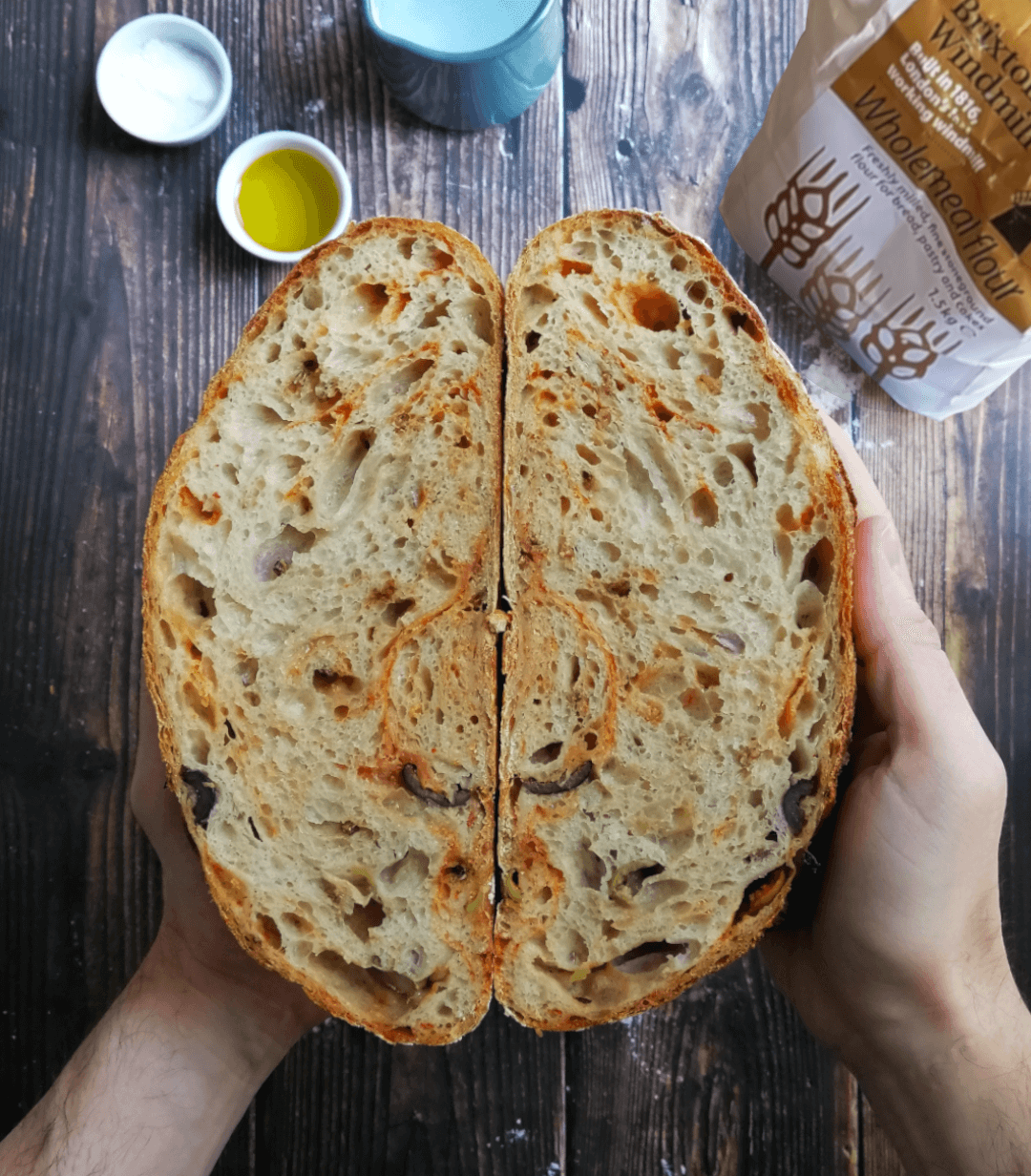It has been a while since I made some sourdough bread. In the last months I quite neglected my starter Kevin due to very irregular feeds. It was time to make amends. Brought my starter up to speed and make this delicious tomato and olives sourdough boule.
Thinking back, I really enjoyed the times when I made bread with some fillings. So I thought to make a loaf using my favourite thing in the world to go into bread dough: olives.
This goes back many years. When I was a kid the bakery where my mom used to buy bread made some small soft bread rolls packed with olive pieces inside. And also some small focaccias topped with olives. These were both my most favourite bread in the world, and I would ask my mum to buy them all the time.
To compliment the olives, what could be better than some tomato puree seasoned with salt, pepper, oregano and olive oil. For a prettier effect, I decided to spread the tomato mix on the bread dough only at the latest lamination step. By doing this, it would come out as thin layers in the bread section. So pretty. Topped it with a generous amount of green and black olives, and folded it in layers for even distribution.
Of course I also used some lovely wholewheat flour to make the loaf more nutritious and to add a rustic flavour, mixed together with a good quality white flour. As an alternative, a multi-seeded or crunch flour mix would work equally well.
The tangy and salty flavour of the olives. The umami of the tomato. The slight acidic flavour of the bread. They all made for an exceptional cob. Needeless to say, it was over before I had the time to say “sourdough”.

Makes one large boule/cob
Ingredients
- 400g good quality bread flour
- 100g wholewheat flour (I used Brixton Windmill) or seeded mix flour.
- 375ml water
- 110g sourdough starter at peak of activity
- 12.5g fine sea salt
- 3 Tbsp tomato puree
- 1 Tbsp water
- 1 Tbsp extra-virgin olive oil
- 2 generous handfuls of pitted green or black olives, torn in half
Method
- Feed your sourdough starter as usual. One hour from its peak of activity, sift both flours into a large bowl. Add almost all the water (keep 25ml aside) and stir to combine until you get a shaggy mass and no more dry bits are left. Cover and leave for 1 hr to autolyse in a warm spot (28˚C)
- Uncover the bowl, mix the salt with the reserved water and stir to start dissolving. Add the mix and sourdough starter and dimple with your fingers to start incorporating. Turn into the bowl until the starter and salty water are absorbed. Knead in a stand mixer with the hook attachment on medium-low speed for 10 minutes. If kneading by hand, knead in the bowl for a few minutes, then use the slap and fold method for a further few minutes (here for a quick tutorial). Once the dough is smooth, transfer to a clean bowl, cover and leave to rise for 30 minutes in a warm spot (26-28˚C)
- Uncover and perform a round of stretch and fold. Lightly wet your hand, pick up a side of the dough, stretch it upwards and fold it over and across the middle. Repeat going around the bowl until all the sides are stretched and folded (quick demonstration video here). Cover and leave to rise for 30 minutes. Repeat once more and leave to rest again for 30 minutes.
- Uncover and perform a lamination. Lighly oil your work surface and tranfer your dough on the surface, sticky side down. Starting from one side, gently pull the dough outwards and repeat going all around the sides, to flatten it and stretch it as much as possible to obtain a wide ans thin layer of dough (make sure the dough does not tear). Fold the dough back onto itself to obtain a ball-like shape, and place it in the bowl covered to relax again for 30 minutes. This procedure is really important to stretch the gluten and oxigenate the dough. You can see a simple demonstration on this video.
- Mix the tomato puree, 1 Tbsp of water and oil and season with some salt and pepper. Once 30 minutes have passed, repeat the lamination stretch as per step 4, but before re-folding the dough on itself, spread the tomato paste mix all over the middle using a brush or a soft spatula. Scatter the olives all over and re-fold the dough onto itself so that the layers of tomato and olives are evenly trapped and distributed in the dough. Shape into a tight ball and place again in the bowl to raise, covered, for 2.5 hours in a warm place.
- Pre-shape your loaf. Using a dough scraper, gently turn your dough onto a clean work surface. Slightly wet your hands if the dough is too sticky. Using the scraper in circular movements, shape your dough into a rough ball, increasing the tension of the ball surface. Do not add flour. Leave to rest uncovered for 15 minutes
- Thoroughly flour your proving basket (or bowl). Using your scraper, flip the dough upside down (sticky side up). Stretch all the sides and tuck them in the middle, to increase the surface tension of the dough, pinching to seal the seam of the loaf. Pick up the dough and quickly transfer it into the floured basket, seam side up. Flour the top of the dough, cover with a plastic bag and transfer to the fridge for overnight fermentation (anything from 8 to 14 hours)
- Warm up your oven to 240 ˚C fan, leaving in the baking tray and an additional ovenproof high-sided metal tray at the bottom. When the oven is ready, boil the kettle. Take the risen dough out of the fridge, cut a round piece of baking parchment, place it over the basket and quickly turn your loaf around and place it on the work surface. Remove the basket from the top and brush off any excess flour. Score a line across the middle of the loaf with a confident stroke or, as I did in this photo, a cross.
- Transfer the loaf to the baking tray, pour boiling water into the bottom tray and quickly close the door. After 30 seconds, open the door and spray water on the hot sides of the oven and quickly close the door again. Bake for 25/30 minutes, then turn the oven down to 200 C fan and bake for another 15 minutes, until the crust is golden, and the loaf is baked through. If the loaf is browning too much, cover with some foil. Once baked, transfer to a cooling rack and leave for at least one hour before cutting and eating

